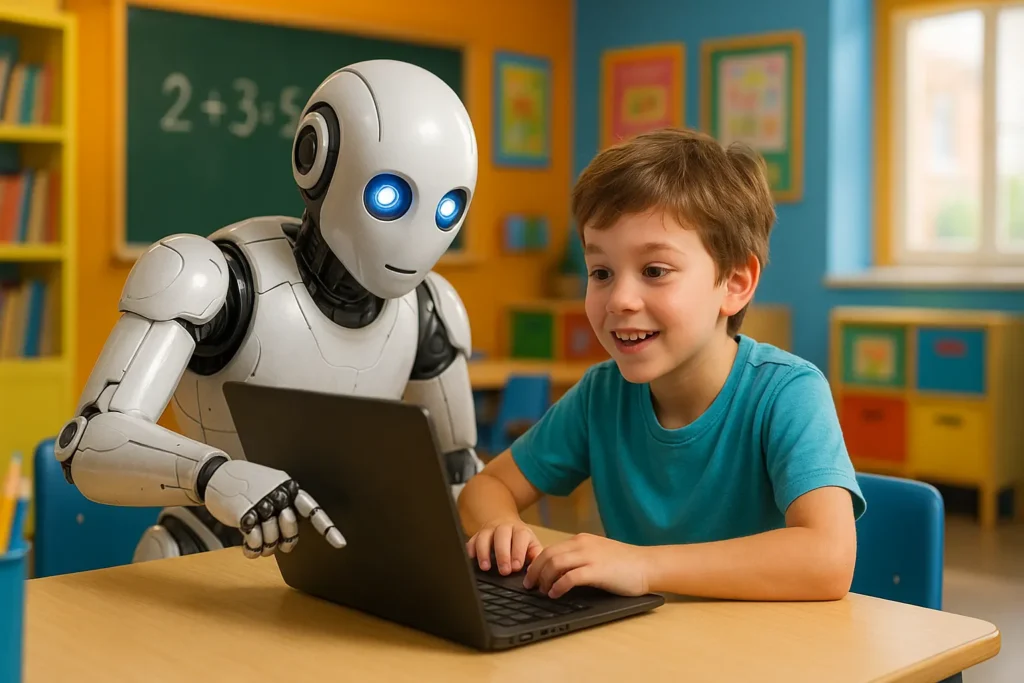Artificial Intelligence (AI) is transforming many areas of our lives — and education is no exception. Today, we’re going to talk about the 10 benefits of using AI in education in a simple and friendly way, like a good chat over coffee. If you’re a teacher, or just curious about how AI can help in the classroom, keep reading. This may surprise you — in a good way.
Why talk about the 10 Benefits of Using AI in Education?
From the moment AI entered the world of education, it brought along new tools, time-saving solutions, and even ways to better understand our students.
At the beginning of this article, we want to make one thing clear: Artificial Intelligence is not here to replace teachers. On the contrary, it’s here to support, to assist, and to bring more possibilities into your teaching routine.
So let’s dive into this together. You’ll see how AI can help with everything from organizing lesson plans to personalizing learning and reducing stress.
1. Personalized Learning for Each Student
Imagine being able to tailor your lessons to each student’s pace, interest, and learning level. Sounds like a dream, right? With AI, this is already a reality.
AI-powered platforms like Khan Academy and Duolingo analyze students’ answers and adapt the content accordingly. If a student struggles with a topic, the system offers more practice. If they’re doing well, it moves forward.
This helps every student feel seen and supported — no one gets left behind.
2. More Time for What Really Matters
Let’s be honest: lesson planning, correcting tests, organizing materials… it’s a lot. AI can take care of the repetitive tasks, giving you more time to focus on teaching and connecting with your students.
For example, tools like Quizlet or Google Classroom can help you generate quizzes, auto-grade answers, and manage assignments easily.
You get to spend more time doing what you love — teaching — and less time buried in paperwork.
3. Real-Time Feedback
Remember the times when you gave an assignment and only realized days later that many students didn’t understand the topic? With AI, you get instant feedback.
Learning platforms can show you which students are struggling, which questions are commonly missed, and even suggest review materials — all in real time.
This way, you can take action right away, not after the test is over.
4. Inclusive Education for Everyone
AI can make learning more accessible for students with disabilities or special needs.
There are AI tools that read texts aloud, convert speech to text, offer real-time subtitles in videos, and even translate content for non-native speakers.
One great example is Microsoft Immersive Reader. It helps students with dyslexia or visual impairments follow along with the class more easily.
That means more students learning with confidence and autonomy.

5. Learning Anytime, Anywhere
AI is behind many educational apps that allow students to learn at their own pace — even outside school hours.
Whether at home, on the bus, or during a quiet moment in the classroom, students can review content, practice skills, or explore new topics using tools like Khan Academy, Socratic, or Photomath.
This flexibility supports students who may not always learn best in traditional settings.
6. Help with Lesson Planning
Tired of spending hours researching, organizing content, and creating activities? AI can help.
Platforms like ChatGPT, Canva for Education and MagicSchool.ai offer ideas for lesson plans, visual materials, quizzes, and even games based on your subject and grade level.
They don’t replace your creativity — they enhance it, and speed things up.
7. Emotional Support and Student Monitoring
Some AI systems can monitor signs of emotional distress or lack of engagement in students.
While they don’t replace human connection, they can be an early alert to help you notice if a student is feeling isolated, unmotivated, or struggling emotionally.
Apps like Replika are even being studied for use as conversation partners to support student well-being.
8. Learning Analytics: Understanding What Works
Wouldn’t it be great to know exactly which teaching strategies work best?
AI platforms can collect and analyze data from your students’ activities to identify what methods are most effective. They help you understand patterns, behaviors, and results — so you can teach smarter, not harder.
9. Encouraging Student Autonomy
With AI tools, students take more control over their learning. They can set goals, check their own progress, and get immediate help when needed.
This builds self-confidence and responsibility — two essential life skills.
Plus, students feel proud when they notice their own progress. That’s a win-win.
10. Professional Growth for Teachers
Finally, AI isn’t just for students. Teachers can use AI to learn too.
There are platforms that recommend training courses, analyze your teaching style, and even help with classroom management.
So while you’re helping your students grow, you’re also evolving — and that’s powerful.

Key Points About 10 Benefits of Using AI in Education
- AI helps personalize learning and adapt content for each student.
- It saves time on repetitive tasks like grading and planning.
- Provides real-time feedback for better student support.
- Encourages inclusive education for students with different needs.
- Allows students to learn anywhere, at any time.
- Assists teachers in planning engaging lessons quickly.
- Can support student emotional health and track engagement.
- Offers learning analytics to improve teaching strategies.
- Promotes student autonomy and self-learning.
- Helps teachers in their own continuous learning.
Conclusion
Artificial Intelligence may sound like something from the future, but it’s already here — and it’s making a difference in classrooms around the world. As we saw, AI is a powerful ally for teachers, offering tools that save time, boost learning, and create a more inclusive and personalized educational experience.
The important thing is to approach these technologies with curiosity and a willingness to learn. AI doesn’t replace your talent or passion — it enhances them. So go ahead, explore a bit. You might find that AI gives you exactly the kind of support you’ve been needing.
What do you think? Have you used AI in your classroom yet? Share your experiences and questions in the comments below — we’d love to hear from you!

